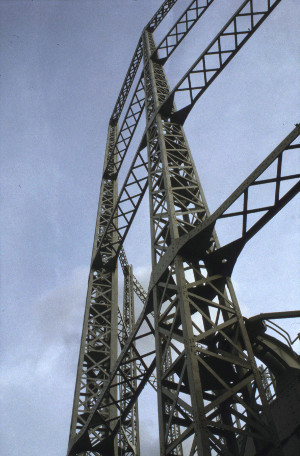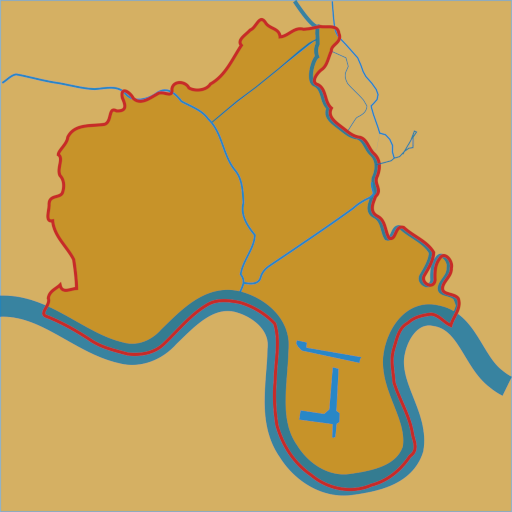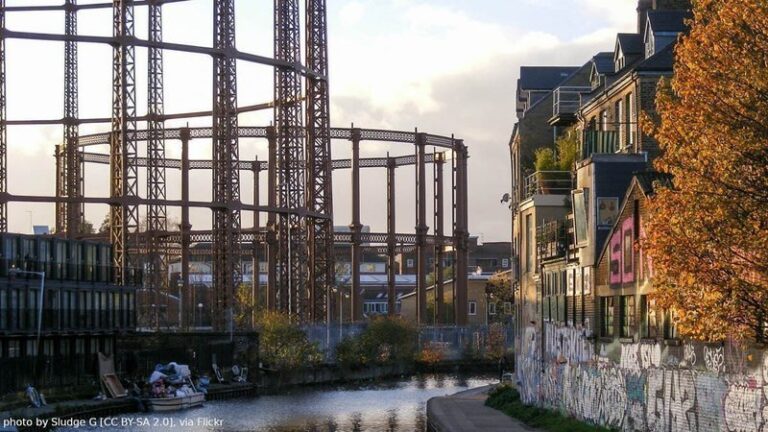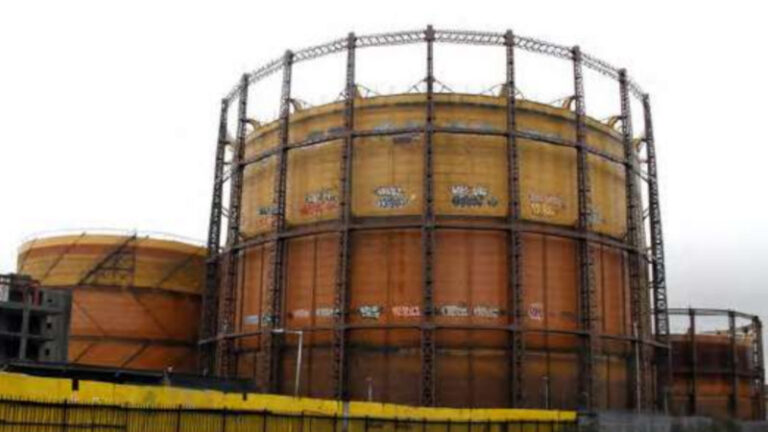THE HISTORIC NO. 1 GASHOLDER AT THE POPLAR HOLDER STATION,
LEVEN ROAD, LONDON BOROUGH OF TOWER HAMLETS

The Poplar Holder Station occupies a small part of the site of the Poplar Gasworks, opened in 1878 by the Commercial Gas Company. This was the East End’s own gas company with its main works at Stepney: opened 1840 on the Regent’s Canal, to the east of St Dunstan’s Church. The company served Stepney and Poplar, including the docks, until nationalisation in 1949.
The No.1 gasholder was the first to be built at Poplar and was designed in 1876 by the company’s engineers, Robert Jones and his son Henry Edward Jones, known as Harry. With the exception of the in-ground concrete tank, it was built 1876-78 by the well-known local firm of Samual Cutler and Sons. It has a very early wrought-iron lattice guide frame of 19 wrought-iron guide standards on a circular in-ground concrete tank 172 feet in diameter and 36 feet in depth. The tank is one of the world’s first mass concrete gasholder tanks. Each elegant tapering guide standard is tee-shaped in cross-section, and consists of a 73-feet-high solid triangle and, at right angles, an equally high lattice-work triangle. The standards are joined by upper and lower rings of girders and diagonal bracing rods.
The lower girders are the first and only surviving examples of their particular type of box-lattice girder. The four corners at each end curve inwards to a smaller, solid-webbed middle section; and look like the joined tops of two miniature Eiffel Towers. The upper girders are replacement rolled I-section beams and match the slim lines of the lower girders and guide standards. The bell consists of two lifts and was re-sheeted in the 1920s with pure rust-resistant Armco iron.
The design of the lattice guide frame standards at Poplar was based on the first of the type, erected at Hove in 1876 as a more easily constructed and stronger alternative to the usual cast-iron columns. However, instead of Hove’s ordinary girders Harry Jones designed the first curved and tapering box-lattice girders for the No. 1 gasholder at Poplar.
The 1876 gasholder at Hove no longer survives. And there are probably only two other surviving early pioneering examples with tee-section lattice guide frame standards, both in London. The No. 1 gasholder at Kennington, near the Oval, was completed a year later in 1879 but its standards were subsequently raised; and the 1882 gasholder at Sydenham. Neither has Poplar’s curved and tapering box-lattice girders. Similar distinctive girders were used elsewhere but none survive.
The lattice guide frame of the No. 1 gasholder at Poplar is therefore not only the earliest surviving example of its type in the country, it is also the country’s only surviving example with curved and tapering box-lattice girders. The retention and refurbishment of the unique and nationally important No.1 gasholder at Poplar will serve as a memorial to the East End’s own gas company, its engineers and the constructional engineering firm of Samuel Cutler and Sons of Millwall, which specialised in the erection of gasholders all over the country.
The No.1 gasholder at Poplar should also be retained and refurbished because it is a member of the most important group of historic gas industry structures in London, which was the birthplace of the gas industry. The other members of this Lower Lea Valley group were all built in connection with the Bromley-by-Bow Gasworks. They include its former coal dock (on the east bank of Bow Creek, more or less opposite the No. 1 gasholder at Poplar); its Grade-II-listed access bridge over the River Lea and Bow Creek; and its seven Grade-II-listed gasholders at the Bromley-by-Bow Holder Station.
All seven gasholders have traditional guide frames with cast-iron columns, which were superseded by guide frames with lattice standards. As the No. 1 gasholder at Poplar wil be the Lower Lea Valley’s only gasholder with a lattice guide frame to compare and contrast with the traditional type at Bromley-by-Bow (and represent the subsequent stage in the evolution of the gasholder guide frame) it should remain a member of the Lower Lea Valley Group. Especially as it is a unique and nationally important gasholder, with exceptionally strong local interest.
To the north of the No.1 gasholder is a late-19th-century meter house. This would have housed the station meter, which measured the volume of purified gas on its way to the gasholders. Clearly, it is associated with the No.1 gasholder and, as a very rare survival in London, it could be retained and adapted for appropriate new use in the proposed park.
Tom Ridge
September 2014
Information from:
London Gasholders Survey, a Report for English Heritage by Malcolm T Tucker (September 2000)
East End Waterway Guide by Tom Ridge (to be published 2014)
East End Waterway Group

Local residents, schools, community groups, amenity societies and businesses working with British Waterways, Tower Hamlets Council and others for the protection and beneficial use of the six-mile waterway ‘ring’, its historic buildings, structures and habitats.


Already demolished and goging to be replaced by tower block with housing.
Any photos?